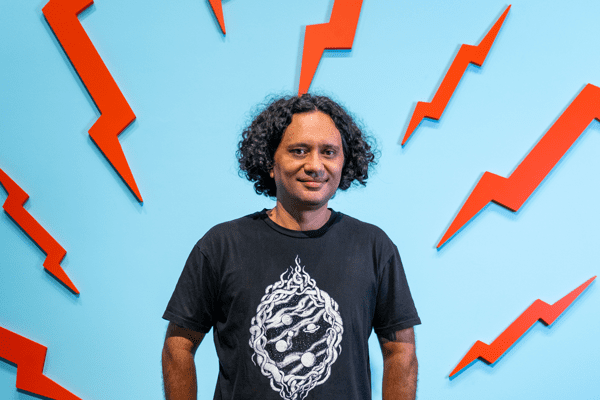Meet the artist bringing colour and meaning to STARS

Samuel Tupou. Courtesy of HOTA, Home of the Arts.
The Surgical, Treatment and Rehabilitation Service (STARS) is home to an exciting and diverse collection of artworks, curated by Lynne Seear, Art Consultant and Manager of the Arts in Health Program for Children’s Health Queensland. The collection includes a significant number of works by Aboriginal and Torres Strait Islander artists.
Some of the most striking pieces in the collection are Botanic Vistas, the panoramic murals by artist Samuel Tupou. Samuel’s artwork consists of five individual paintings located in the public lift lobbies on floors three to seven at STARS.
Each mural creates an impressive visual display of colour and pattern for patients, families and visitors to STARS who are accessing the building through the public lifts and stairs. The artworks feature a heavy pixelation design, with each painting made up of hundreds of circular pixels.
Botanic Vistas draw inspiration from both iconic Queensland landscapes including the Atherton Tablelands and Mt Coolum, and Australian flora. The botanical species featured in the artworks are those that have been named in honour of Australian medical practitioners, highlighting the close connection between medical research and the study of the natural world.
The flora included in the artwork located on Level 6, for example, features Denrobium kestevenji, an orchid native to Queensland and northern New South Wales. The orchid is named after Hereward Leighton Kesteven (1881-1964), general practitioner, medical scientist, zoologist and pioneer of industrial medicine in Australia.
Samuel’s work has a strong sense of pattern, influenced by Pacific Island tapa cloth, part of his Tongan and Polynesian heritage. Tapa cloth design has a repetition of symbols and motifs and often relates to a ceremonial narrative.
“At a distance the pixels form a colourful panorama of landscapes and plant life, yet upon close proximity are intended to distort into an abstract mix of colour and pattern,” said Samuel.
“Human memory is also key element of this work. I am interested in how visual memories fade over time, often leaving only a small amount of information and cornerstone details, forcing us to squint to recall past experiences or environments more clearly.
“We strive to preserve moments of importance or great beauty, when arriving at a vista we capture the moment with a photograph or a mental snapshot to keep for future recollection.”
